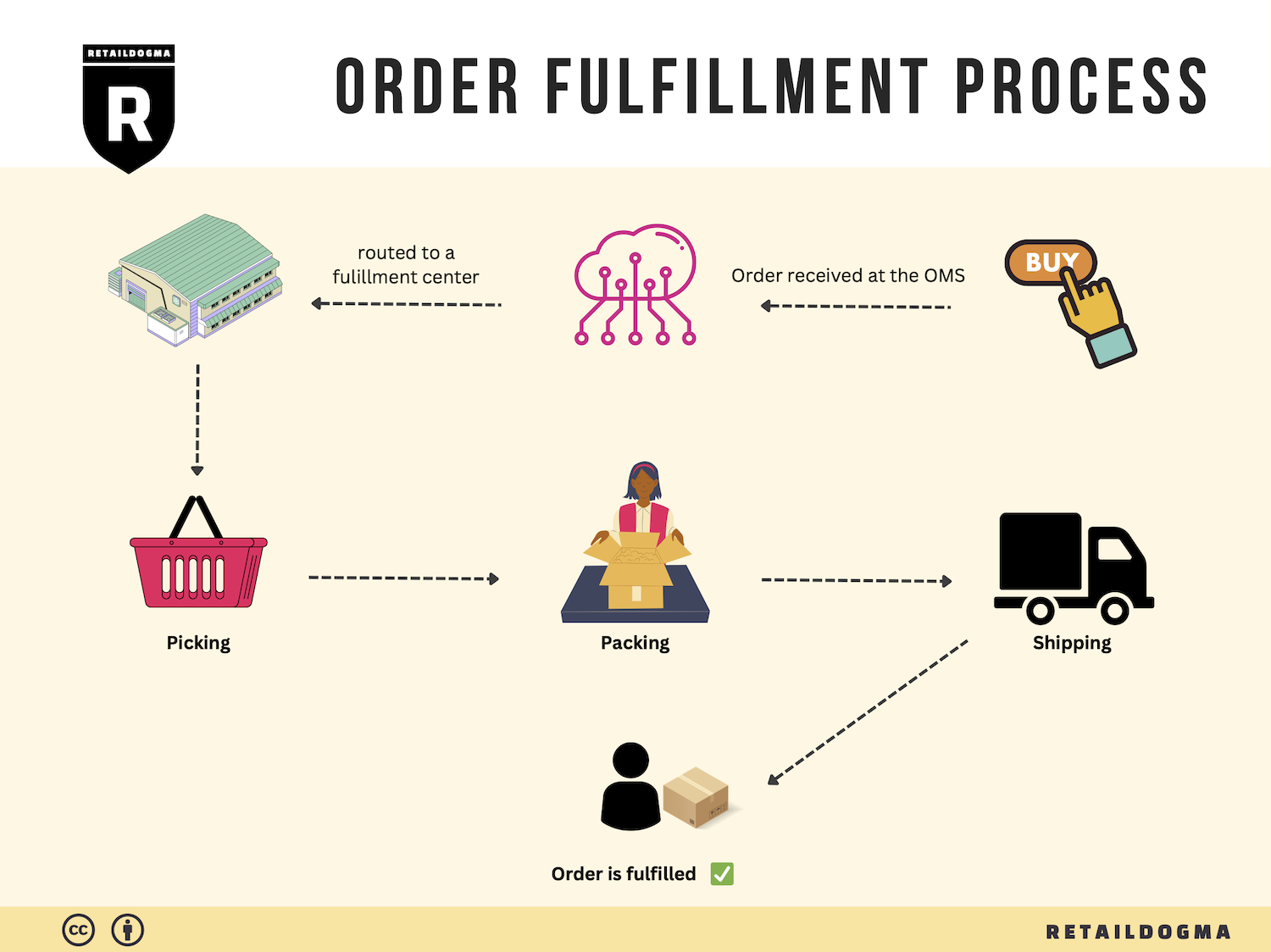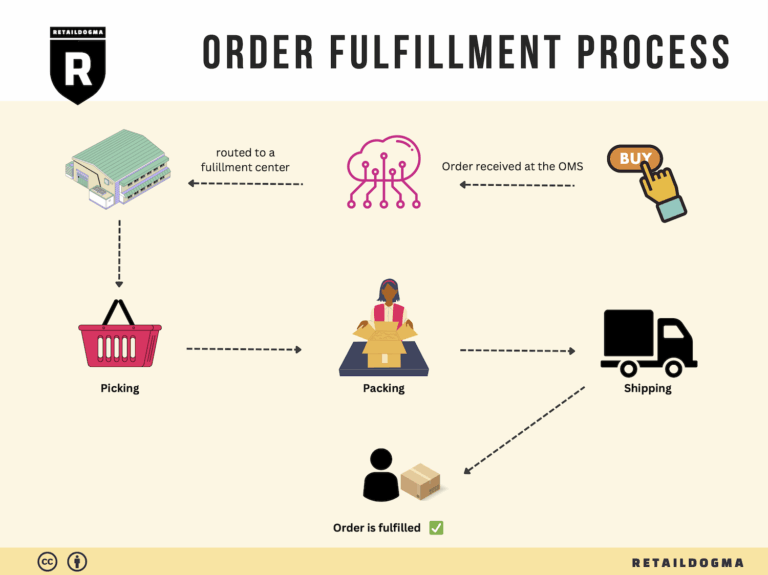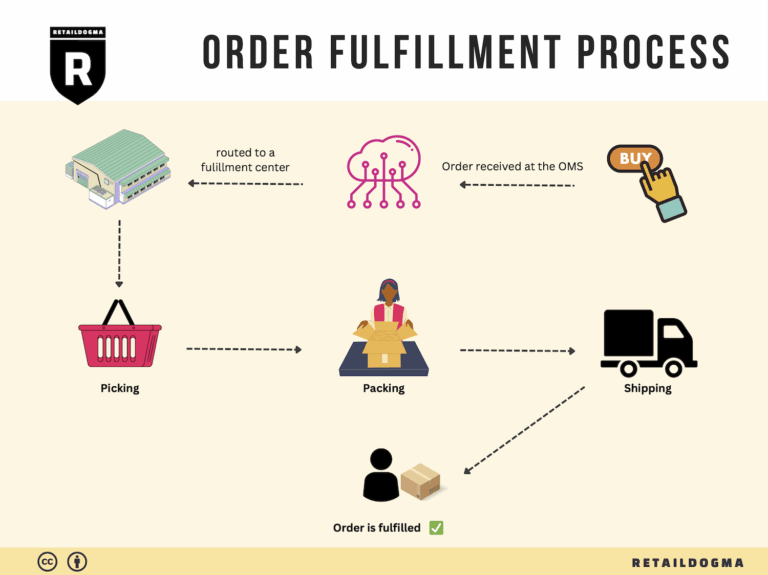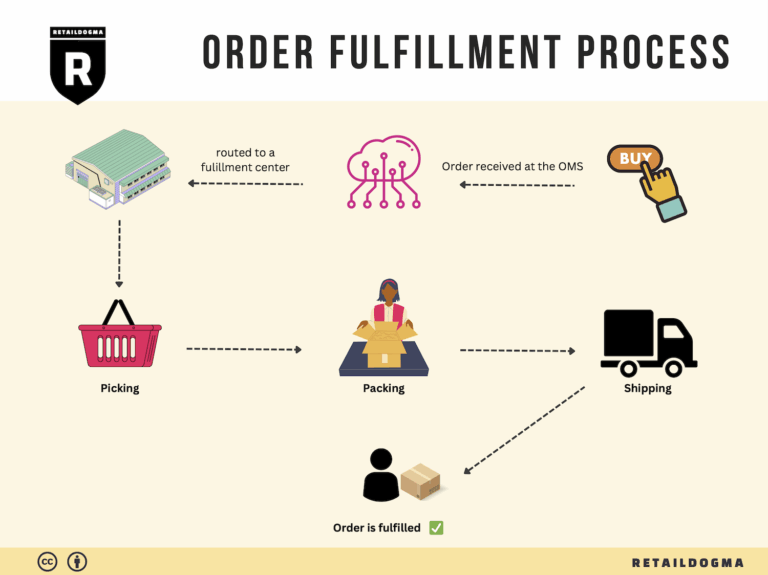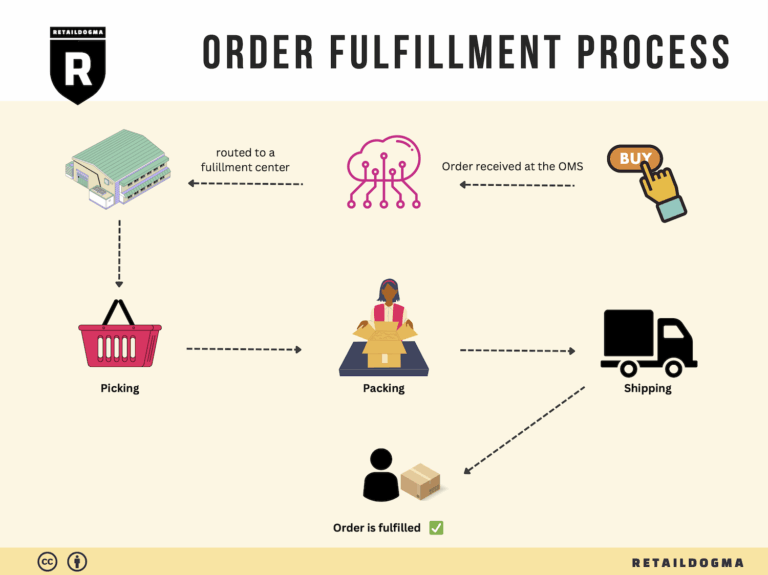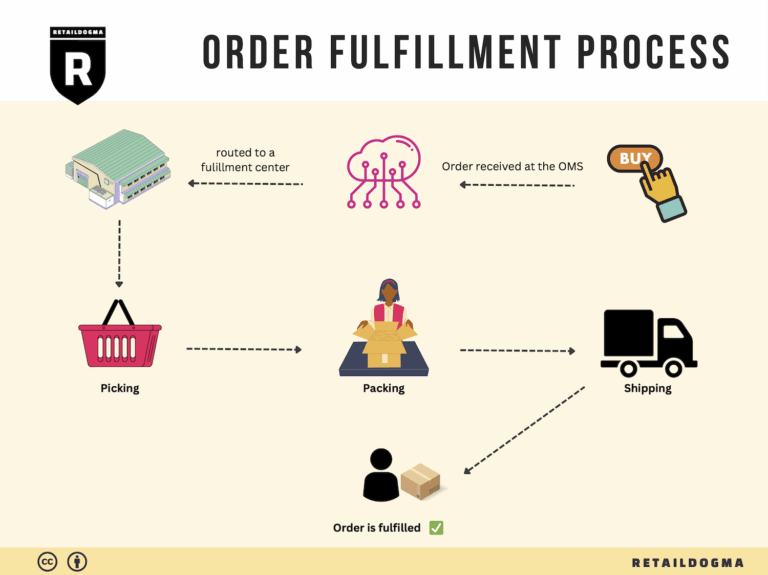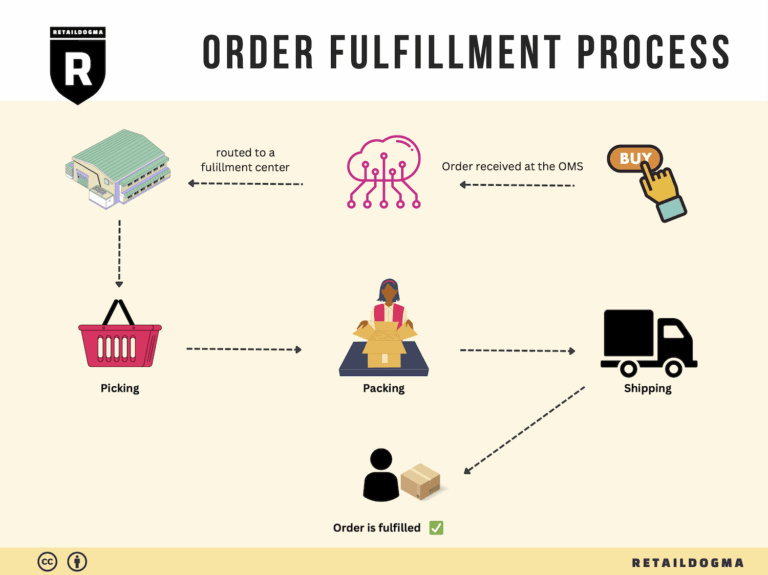How Order Fulfillment Works: A Step-by-Step Guide for Businesses
What is E-commerce Fulfillment? An Introduction for Growing Businesses
Understanding E-commerce Fulfillment
For many growing online businesses, the logistics of packing and shipping orders can quickly become overwhelming. As sales increase, so does the complexity of getting products from your warehouse to your customers’ doorsteps. From managing inventory levels to ensuring timely deliveries, the demands of e-commerce fulfillment can often distract you from focusing on core business strategies.
At its essence, fulfillment is the process of getting a product to a customer. This involves not just the physical act of packing and shipping, but also managing inventory, processing orders, and handling returns. Efficient fulfillment is crucial for maintaining customer satisfaction and loyalty, which are vital for long-term growth in the competitive e-commerce landscape.
This guide aims to demystify the world of e-commerce fulfillment for business owners, operations managers, and entrepreneurs looking to scale their logistics. We will explore various fulfillment models, including Third-Party Logistics (3PL) and Fulfillment by Amazon (FBA), helping you understand the strengths and weaknesses of each.
Key Areas Covered in This Guide
-
Fulfillment Models: Gain insight into different fulfillment strategies available to e-commerce businesses, including in-house fulfillment, outsourcing to a 3PL, and leveraging platforms like Amazon FBA. Each option has unique benefits that can align with your business goals and customer expectations.
-
Core Services: Learn about the essential services involved in the fulfillment process, such as inventory management, order processing, packing, shipping, and returns handling. Understanding these services will help you evaluate potential partners effectively.
-
Choosing the Right Partner: Selecting a fulfillment partner is a critical decision that can impact your operational efficiency and customer experience. We will provide a checklist of criteria to consider when assessing potential partners, ensuring you make an informed choice.
-
Pricing Structures: Navigate the often-complex landscape of fulfillment pricing. We will break down common pricing models, including per-order fees, storage fees, and shipping costs, so you can budget effectively and avoid unexpected expenses.
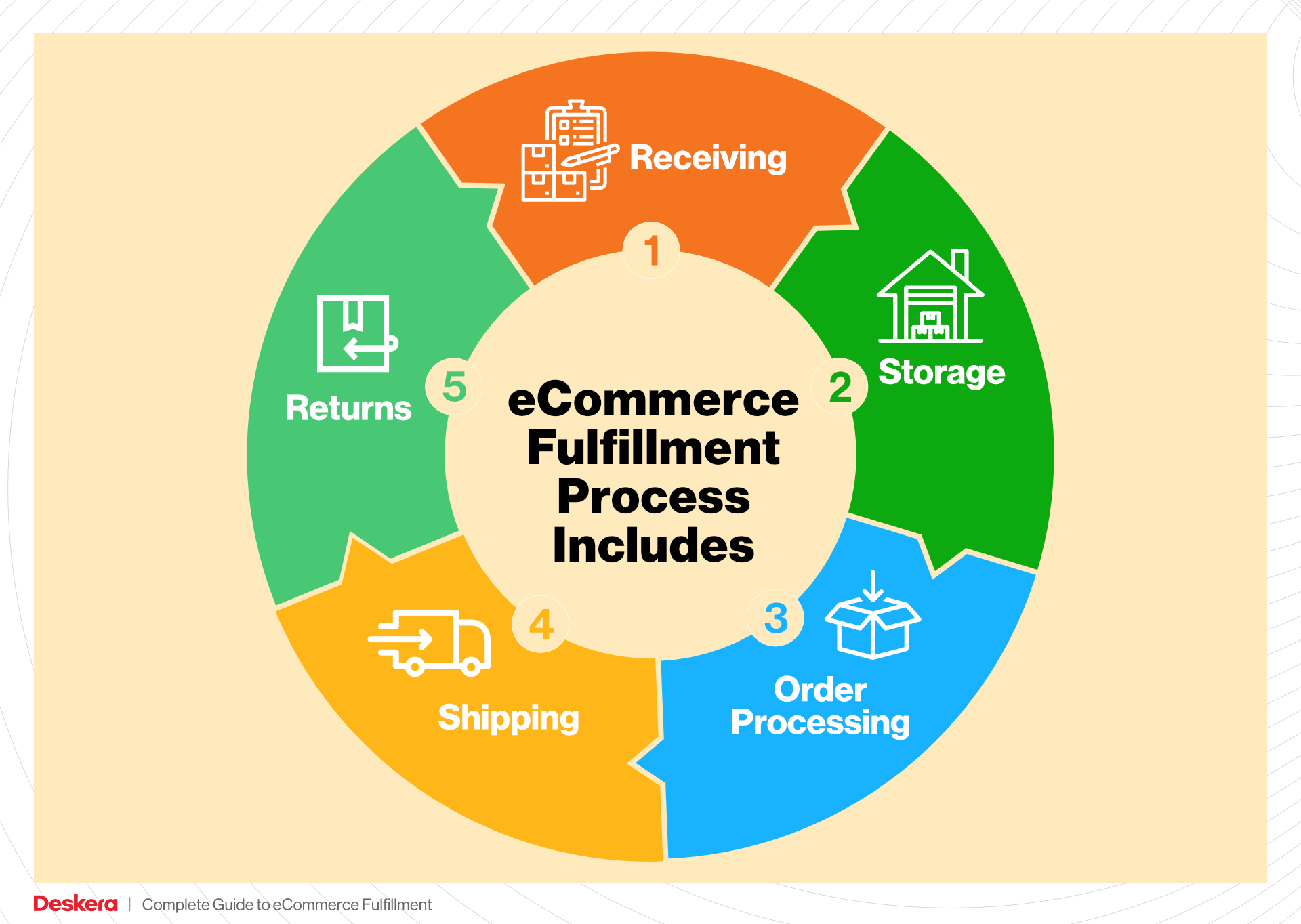
Empowering Your Business Decisions
The ultimate goal of this guide is to empower you to make informed decisions about your logistics and fulfillment strategies. By understanding the various options and factors at play, you can optimize your operations, enhance customer satisfaction, and scale your business effectively. Whether you’re just starting or looking to refine your existing processes, this guide provides the practical insights you need to succeed in the dynamic world of e-commerce fulfillment.
What You’ll Learn In This Guide
- What is E-commerce Fulfillment? An Introduction for Growing Businesses
- The Order Fulfillment Process: From ‘Buy’ Button to Customer’s Door
- Comparing Fulfillment Models: In-House vs. 3PL vs. Dropshipping
- A Deep Dive into Amazon FBA: Pros, Cons, and Who It’s For
- Core Services Offered by Fulfillment Centers
- How to Choose a Fulfillment Partner: A 6-Point Checklist
- Understanding Fulfillment Pricing: A Breakdown of Common Fees
- Frequently Asked Questions (FAQs) about Fulfillment
- Conclusion: Is Outsourcing Fulfillment the Right Move for Your Business?
- Important Disclaimer
The Order Fulfillment Process: From ‘Buy’ Button to Customer’s Door
1. Receiving Inventory
The first step in the order fulfillment process is receiving inventory. This stage involves the acceptance of goods from suppliers or manufacturers into a warehouse or fulfillment center. Upon arrival, products are carefully inspected for quality and quantity against the purchase order to ensure that everything matches expectations. This process is essential for maintaining accurate stock levels and preventing discrepancies that could disrupt future order fulfillment.
A key term associated with this step is SKU (Stock Keeping Unit). Each product typically has a unique SKU, which helps in tracking inventory efficiently. Accurate receiving processes not only help to ensure that the right products are available for customers but also support better inventory management practices, ultimately leading to reduced costs and improved customer satisfaction.
2. Warehouse Storage
Once inventory is received, it moves into the warehouse storage phase. During this step, products are organized and stored in designated locations within the fulfillment center. Efficient storage methods, such as utilizing shelving systems or automated storage solutions, play a critical role in maximizing space and accessibility.
The importance of this step lies in its impact on retrieval efficiency. Proper organization reduces the time it takes to locate items during order picking, which can significantly enhance overall fulfillment speed. A key term here is bin location, which refers to the specific area or slot where an item is stored. By employing systematic storage strategies—like FIFO (First In, First Out) or LIFO (Last In, First Out)—businesses can optimize their inventory turnover rates and minimize holding costs.
3. Order Picking
The third step is order picking, where warehouse staff or automated systems retrieve items from storage to fulfill customer orders. This process can involve various methods, including batch picking, zone picking, or wave picking, depending on the fulfillment center’s size and the volume of orders.
Order picking is crucial because it directly affects the accuracy and speed of order fulfillment. Errors at this stage can lead to customer dissatisfaction and increased return rates. A key term associated with order picking is pick lists. These documents or digital interfaces guide staff on which items to retrieve and their respective quantities. Implementing efficient picking methods can significantly reduce labor costs and increase throughput, enabling businesses to scale operations effectively.

4. Order Packing
After items are picked, they move to the order packing stage. Here, the selected products are carefully packed into boxes or envelopes, ensuring they are protected during transit. Packing involves not only placing items into packaging but also including necessary documentation, such as packing slips or invoices.
This step is vital for ensuring that customers receive their orders in perfect condition. A well-executed packing process minimizes the risk of damage during shipping and enhances the overall customer experience. A key term related to this step is packing materials, which include boxes, bubble wrap, and cushioning materials that safeguard products. By investing in quality packing solutions and employing efficient packing methods, businesses can reduce shipping costs and improve delivery times.
5. Shipping & Delivery
The final step in the order fulfillment process is shipping and delivery. Once packages are packed, they are labeled and prepared for shipment. This involves selecting the appropriate shipping carrier and service level based on factors such as destination, delivery speed, and cost.
Shipping and delivery are crucial as they represent the last interaction a customer has with a business regarding their order. Timely delivery is essential for customer satisfaction and can significantly impact repeat business and brand loyalty. A key term associated with this step is last-mile delivery, which refers to the final leg of the shipping journey from a distribution center to the customer’s doorstep. Efficient last-mile delivery solutions can help businesses meet customer expectations for speed and reliability, ultimately driving sales growth and enhancing competitive advantage.
By understanding and optimizing each step in the order fulfillment process, e-commerce businesses can scale their operations effectively, enhance customer satisfaction, and maintain a competitive edge in the ever-evolving marketplace.
Comparing Fulfillment Models: In-House vs. 3PL vs. Dropshipping
Comparison of Fulfillment Models
| Model | Who Handles Inventory | Best For (Business Stage) | Key Advantage | Key Disadvantage |
|---|---|---|---|---|
| In-House Fulfillment | The business itself | Established businesses with stable sales | Full control over inventory and operations | High overhead costs and resource requirements |
| Third-Party Logistics (3PL) | A third-party provider | Growing businesses looking to scale | Cost efficiency and expertise in logistics | Less control over inventory and processes |
| Dropshipping | Suppliers or manufacturers | Startups or businesses testing products | Low upfront investment and risk | Lower profit margins and dependency on suppliers |
In-House Fulfillment
In-house fulfillment refers to a model where a business manages its own inventory and logistics operations. This means that the company is responsible for storing, picking, packing, and shipping its products directly from its own warehouse or storage facility. This model is best suited for established businesses with stable sales and a consistent volume of orders. One of the primary advantages of in-house fulfillment is the level of control it offers over inventory management and the entire fulfillment process. Businesses can closely monitor stock levels, implement their own quality control measures, and ensure that customer orders are fulfilled according to their specific standards. However, this model comes with significant overhead costs, including warehousing, staffing, and technology expenses. Additionally, managing logistics in-house requires a substantial investment in infrastructure and resources, which can be a barrier for smaller businesses or those experiencing rapid growth.
Third-Party Logistics (3PL)
Third-party logistics (3PL) involves outsourcing fulfillment operations to a specialized logistics provider. This model is ideal for growing businesses that are looking to scale their operations without the complexities of managing inventory and shipping themselves. A 3PL provider typically handles warehousing, inventory management, order fulfillment, and shipping, allowing businesses to focus on core activities such as marketing and product development. The key advantage of using a 3PL is cost efficiency; businesses can leverage the provider’s expertise and established infrastructure, which can lead to lower shipping rates and reduced operational costs. However, one of the main drawbacks of this model is the potential loss of control over inventory and fulfillment processes. Relying on a third party means that businesses must trust their provider to maintain quality standards and meet delivery expectations, which can lead to challenges in customer satisfaction if issues arise.
Dropshipping
Dropshipping is a fulfillment model where a retailer does not hold any inventory but instead relies on suppliers or manufacturers to fulfill customer orders directly. This model is particularly advantageous for startups or businesses testing new products, as it requires minimal upfront investment and allows for flexibility in product offerings. Retailers can list a wide range of products without the financial burden of purchasing inventory upfront. The key advantage of dropshipping is the low risk associated with entering new markets; businesses can experiment with different products without significant financial commitment. However, dropshipping also comes with notable disadvantages, including lower profit margins and reliance on suppliers for inventory management and shipping. This dependency can lead to challenges in maintaining consistent quality and timely delivery, which can ultimately impact customer satisfaction and brand reputation.
Conclusion
Choosing the right fulfillment model is critical for e-commerce businesses aiming to scale their operations effectively. Each model—In-House Fulfillment, Third-Party Logistics, and Dropshipping—offers distinct advantages and disadvantages that must be carefully evaluated based on the specific needs and stage of the business. Understanding these differences can help entrepreneurs and operations managers make informed decisions that align with their growth objectives and operational capabilities. As e-commerce continues to evolve, businesses should remain agile and consider integrating multiple fulfillment strategies to optimize their logistics and meet customer demands efficiently.
A Deep Dive into Amazon FBA: Pros, Cons, and Who It’s For
What is Fulfillment by Amazon (FBA)?
Fulfillment by Amazon (FBA) is a service provided by Amazon that allows e-commerce sellers to store their products in Amazon’s fulfillment centers. Amazon then takes care of the storage, packaging, and shipping of these products directly to customers. This service not only handles logistics but also integrates with Amazon’s extensive customer service and returns management, making it an attractive option for businesses looking to scale their operations.
When a customer places an order for a product listed on Amazon that is fulfilled by FBA, the order is automatically routed to the nearest Amazon fulfillment center. The product is picked from the inventory, packed, and shipped directly to the customer, often with the added benefit of fast, reliable delivery options such as Amazon Prime. Sellers can track their inventory and sales through the Amazon Seller Central platform, allowing for streamlined management of their operations.
How Does FBA Work?
-
Inventory Management: Sellers send their products to Amazon’s fulfillment centers. They can monitor their inventory levels and receive alerts when stock is running low.
-
Order Processing: Once a customer makes a purchase, Amazon picks, packs, and ships the product on behalf of the seller.
-
Customer Service and Returns: Amazon handles all customer service inquiries and processes returns for FBA products, which simplifies operations for sellers and enhances the customer experience.
-
Multi-Channel Fulfillment: Sellers can use FBA not only for orders placed on Amazon but also for orders from other sales channels, such as their own website or other e-commerce platforms.
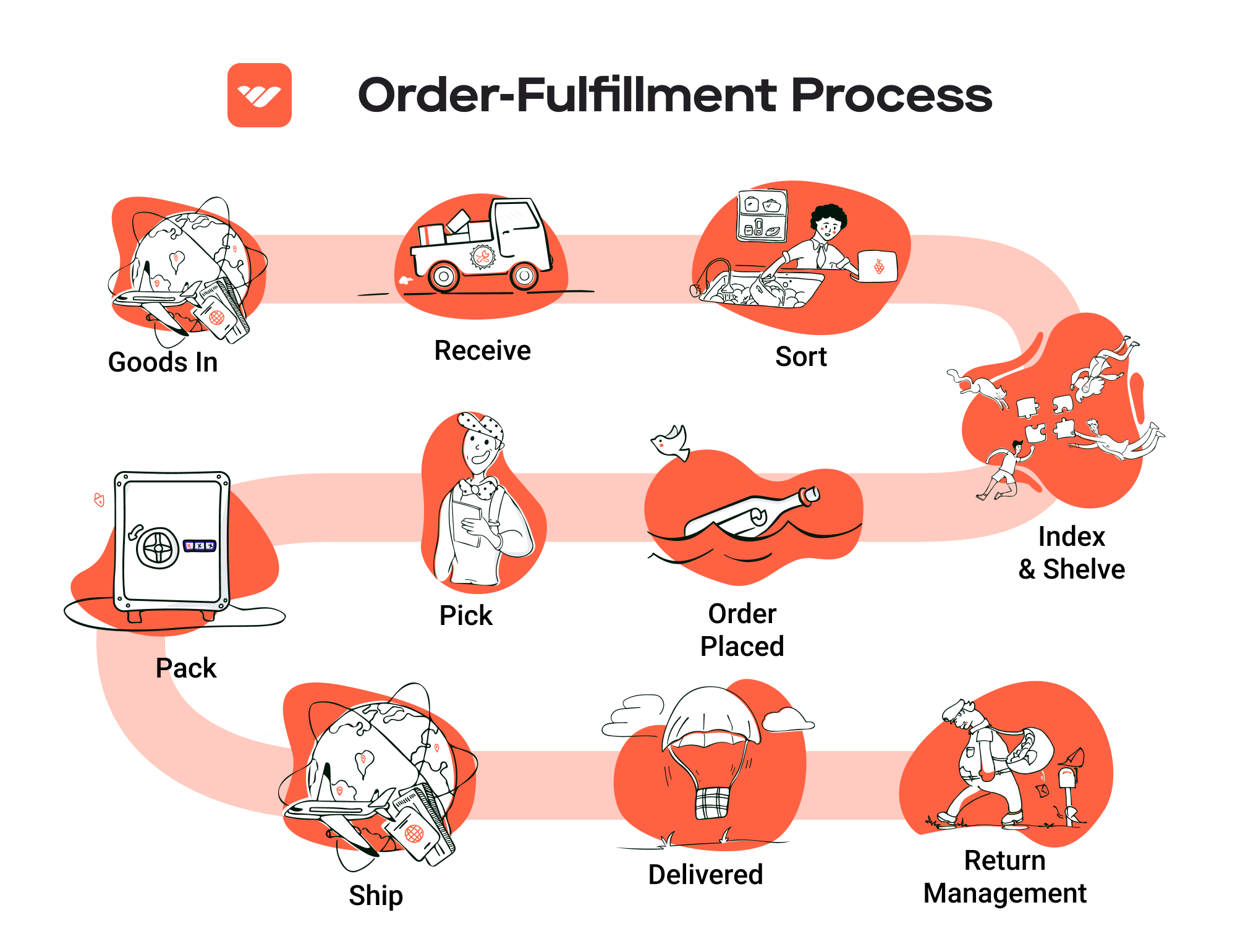
Pros of Fulfillment by Amazon (FBA)
-
Prime Eligibility: Products fulfilled by Amazon are automatically eligible for Amazon Prime, which can significantly increase sales. Prime members often prefer items that qualify for two-day shipping, providing sellers with a competitive edge.
-
Customer Trust: Leveraging Amazon’s brand reputation can enhance trust in your products. Customers are more likely to purchase items from sellers who utilize FBA due to the reliable service and return policies associated with Amazon.
-
Multi-Channel Fulfillment: FBA allows sellers to fulfill orders from multiple channels. This means that sellers can use Amazon’s robust logistics network to fulfill orders from their own websites or other marketplaces, broadening their reach without needing to manage a separate logistics operation.
-
Scalability: As businesses grow, FBA can easily accommodate increased sales volume without the need for sellers to invest in additional warehousing or logistics staff. This scalability allows businesses to focus on marketing and product development.
-
Time Savings: By outsourcing fulfillment to Amazon, sellers can save significant time and resources that would otherwise be spent on managing inventory, packaging, and shipping logistics.
Cons of Fulfillment by Amazon (FBA)
-
High Fees: FBA comes with various fees, including storage fees for inventory and fulfillment fees for each unit sold. These costs can add up, especially for sellers with low-margin products or those who hold large amounts of inventory.
-
Strict Inventory Rules: Amazon has stringent requirements regarding inventory management, including restrictions on the types of products that can be stored in their warehouses and strict guidelines for packaging and labeling. Non-compliance can lead to additional fees or removal of listings.
-
Commingling Risks: FBA utilizes a commingled inventory model, meaning that products from multiple sellers can be stored in the same location. This can lead to concerns about counterfeit products or mislabeling, which can negatively affect a seller’s reputation and lead to customer dissatisfaction.
-
Loss of Control: By using FBA, sellers relinquish some control over the fulfillment process, including packaging choices and customer interaction. This can impact branding efforts and the overall customer experience.
-
Inventory Limitations: Amazon may impose limits on the amount of inventory a seller can send to their fulfillment centers, especially if they are new or have low sales velocity. This can hinder a seller’s ability to scale quickly.
Who is FBA Best For?
Fulfillment by Amazon is ideally suited for e-commerce businesses looking to scale quickly without the overhead of managing logistics. It is particularly advantageous for:
-
Small to Medium-Sized Businesses: Those without the resources to manage their own warehousing and fulfillment operations can benefit significantly from Amazon’s infrastructure.
-
Sellers with High Sales Volume: Businesses that anticipate high sales volumes can leverage FBA to handle the logistics efficiently, ensuring timely delivery to customers.
-
New Sellers: Startups and new sellers can gain immediate access to Amazon’s vast customer base and trusted fulfillment network, which can help them build credibility and drive sales from the outset.
-
Brands Seeking to Expand Reach: Companies looking to diversify their sales channels and reach customers outside of Amazon can utilize FBA for multi-channel fulfillment, ensuring that they can meet customer demands across various platforms.
In summary, while FBA offers numerous benefits that can significantly enhance an e-commerce business’s operational efficiency and sales potential, it is essential for sellers to carefully weigh the associated costs and challenges. By understanding both the pros and cons, businesses can make informed decisions about whether FBA aligns with their growth strategy and operational capabilities.
Core Services Offered by Fulfillment Centers
Inventory Management & Warehousing
Inventory management and warehousing are foundational services provided by fulfillment centers, designed to ensure that e-commerce businesses maintain optimal stock levels while minimizing excess inventory. Fulfillment centers utilize sophisticated inventory management systems that track stock in real time, allowing businesses to know exactly what products are available and where they are located within the warehouse.
The benefits of effective inventory management include reduced holding costs, improved cash flow, and minimized stockouts or overstock situations. For e-commerce businesses, this means they can respond swiftly to market demands, avoiding lost sales opportunities and ensuring customer satisfaction through timely order fulfillment. Furthermore, a well-organized warehouse layout enhances picking efficiency, which is critical for quick processing of orders.
Pick and Pack Services
Pick and pack services are essential for the efficient processing of customer orders. This service involves selecting items from inventory (picking) and preparing them for shipment (packing). Fulfillment centers employ trained staff and automated systems to streamline this process, ensuring that orders are accurately fulfilled and packaged according to specific requirements.
The primary benefit of pick and pack services is the speed and accuracy with which orders are processed. With the rise of consumer expectations for fast delivery, e-commerce businesses can significantly enhance their operational efficiency by leveraging these services. A well-executed pick and pack process minimizes errors, reduces the time taken to ship products, and ultimately leads to higher customer satisfaction. Additionally, fulfillment centers can often accommodate custom packaging and branding options, providing businesses with a unique way to enhance their brand identity.
Kitting and Assembly
Kitting and assembly are specialized services that allow e-commerce businesses to combine multiple items into a single, ready-to-ship package. This can include bundling products that are frequently purchased together or assembling complex items that require multiple components. Fulfillment centers have the capability to manage these processes efficiently, utilizing skilled labor and appropriate tools to ensure that kitting and assembly meet quality standards.
The advantages of kitting and assembly services are significant for businesses looking to optimize their product offerings. By offering bundled products, businesses can increase average order value and enhance customer convenience. Additionally, having products pre-assembled or packaged can reduce the time spent on order fulfillment, allowing for quicker turnaround times. This service is particularly beneficial during peak seasons or promotional campaigns when demand may surge, enabling businesses to respond effectively without the need for additional labor or resources.
Returns Management (Reverse Logistics)
Returns management, also known as reverse logistics, is a critical component of fulfillment services that addresses the processing of returned merchandise. This service includes receiving returned items, inspecting their condition, restocking them if they are in sellable condition, and managing the disposal or recycling of damaged products. Fulfillment centers provide the necessary infrastructure and expertise to handle returns efficiently, ensuring that the process is seamless for both the business and the customer.
The benefits of effective returns management are profound, particularly in the e-commerce landscape where return rates can be high. A streamlined returns process enhances customer trust and satisfaction, as consumers appreciate hassle-free returns. This can lead to increased customer loyalty and repeat purchases. Additionally, by managing returns effectively, businesses can recover value from returned products, reducing losses associated with unsold inventory. Fulfillment centers can also provide valuable insights into return trends, helping businesses to adjust their offerings and improve product quality, ultimately reducing future return rates.
Conclusion
In summary, fulfillment centers offer a range of core services that are vital for e-commerce businesses aiming to scale their operations. By leveraging inventory management and warehousing, pick and pack services, kitting and assembly, and returns management, businesses can enhance operational efficiency, improve customer satisfaction, and ultimately drive growth. As the e-commerce landscape continues to evolve, partnering with a reliable fulfillment center can provide the competitive edge needed to thrive in a fast-paced market.
How to Choose a Fulfillment Partner: A 6-Point Checklist
Location & Warehouse Network
The geographical location of your fulfillment partner is critical to ensuring efficient shipping and reducing delivery times. A partner with a well-placed network of warehouses can facilitate faster last-mile delivery, which is increasingly important in the e-commerce sector.
Why It’s Important:
– Proximity to your customer base can significantly impact shipping costs and delivery speed.
– A strategic warehouse network can help you reach more customers with less shipping time, enhancing customer satisfaction.
Questions to Ask:
– Where are your warehouses located, and how does this align with our target market?
– Can you provide details on your network’s coverage area?
– How do you handle inventory distribution across your warehouse locations?
Technology & Integrations
A robust technology platform is essential for seamless operations. Your fulfillment partner should be equipped with a user-friendly system that integrates well with your e-commerce platform, inventory management tools, and other critical systems.
Why It’s Important:
– Efficient technology reduces the risk of errors in order processing and inventory management.
– Real-time data access allows for better decision-making and faster response to market changes.
Questions to Ask:
– What technology do you use for order management and inventory tracking?
– Can your system integrate with our existing e-commerce platforms (e.g., Shopify, WooCommerce)?
– How do you handle data security and backup?
Specializations (e.g., Cold Storage, Oversized Items)
Not all fulfillment partners offer the same range of services. Depending on your product types, you may require specialized storage solutions, such as cold storage for perishables or facilities that can handle oversized items.
Why It’s Important:
– Choosing a partner with the right specializations can prevent potential damages and compliance issues.
– Specialized services can enhance your brand reputation by ensuring your products are handled appropriately.
Questions to Ask:
– What specific services do you offer that cater to our product needs?
– Do you have experience handling our type of products?
– Can you provide case studies or references for similar businesses?
Scalability & Capacity
As your business grows, so will your fulfillment needs. Your partner should have the capacity to scale operations in line with your growth, whether it’s seasonal spikes or long-term expansion.
Why It’s Important:
– A partner that can scale quickly will help you seize market opportunities without missing a beat.
– Understanding capacity limits will help you avoid stockouts or delays during peak times.
Questions to Ask:
– What is your current capacity, and how do you manage fluctuations in demand?
– How quickly can you scale up operations if our order volume increases?
– Do you have contingency plans for peak seasons or unexpected growth?
Pricing and Contracts
Transparent pricing structures and flexible contracts are essential for maintaining a healthy bottom line. You should understand all costs involved, including hidden fees, and negotiate terms that allow for growth and flexibility.
Why It’s Important:
– Clear pricing helps in budgeting and forecasting.
– Flexible contracts can provide room for adjustments based on changing business needs.
Questions to Ask:
– Can you provide a detailed breakdown of your pricing structure?
– Are there any additional fees (e.g., for storage, returns, or technology usage)?
– What are the terms of your contract, and is there room for renegotiation?
Customer Support & Reviews
Exceptional customer support can make a significant difference in your operations. Your fulfillment partner should offer reliable support and have a solid reputation among its clients.
Why It’s Important:
– Responsive customer service ensures issues are resolved quickly, minimizing disruptions.
– Positive reviews and testimonials can provide insight into the partner’s reliability and quality of service.
Questions to Ask:
– What customer support options do you offer (e.g., phone, email, live chat)?
– How do you handle issues or disputes that may arise?
– Can you provide references or case studies from current or past clients?
Conclusion
Choosing the right fulfillment partner is a pivotal decision for e-commerce businesses looking to scale effectively. By using this checklist, you can evaluate potential partners thoroughly, ensuring they meet your operational needs and align with your growth strategy. Remember, the goal is to find a partner that complements your business model and enhances your customer experience while supporting your overall objectives.
Understanding Fulfillment Pricing: A Breakdown of Common Fees
Initial Setup Fees
When partnering with a fulfillment center, businesses often encounter initial setup fees. These fees cover the costs associated with onboarding your products into the fulfillment system. This process typically includes creating and configuring your account, integrating your e-commerce platform with the fulfillment center’s technology, and setting up inventory management systems.
The calculation of initial setup fees can vary widely based on the complexity of the integration and the number of SKUs you are onboarding. Some fulfillment centers may charge a flat fee, while others might have tiered pricing based on the volume of products or specific services required. It’s essential to clarify what is included in these fees to avoid unexpected costs later.
Receiving Fees
Receiving fees are incurred when the fulfillment center accepts and processes your inventory. This fee covers the labor and resources needed to unload, inspect, and store your products.
Typically, receiving fees are calculated per pallet or per unit, depending on how the fulfillment center structures its pricing. For instance, some centers may charge a flat rate for receiving a pallet of goods, while others might charge per item within that pallet. Factors influencing these fees include the size and weight of the products, as well as the complexity of the receiving process (e.g., special handling requirements).
Storage Fees (per pallet/bin)
Storage fees apply to the inventory you have stored within the fulfillment center. These fees are crucial for managing your ongoing costs associated with holding stock.
Most fulfillment centers charge storage fees on a monthly basis, calculated either per pallet or per bin. The fee structure might vary based on the time of year, with higher rates during peak seasons (such as holidays) when demand for storage space increases. Additionally, some facilities offer tiered pricing; for instance, the first few pallets may have a lower rate, while additional pallets incur higher fees. Understanding these fees can help businesses manage their inventory turnover and storage strategies more effectively.
Pick & Pack Fees (per item/order)
Pick and pack fees are charged for the labor involved in retrieving items from storage, packing them for shipment, and preparing them for delivery. This fee is a critical component of the fulfillment pricing model, as it directly correlates with the volume of orders you process.
These fees can be structured in various ways: some fulfillment centers charge a flat rate per order, while others may charge based on the number of items picked and packed. For example, if your order consists of multiple items, you might incur additional fees for each item beyond the first. It’s essential to clarify whether the quoted fee includes packing materials or if those are billed separately.
Shipping Fees
Shipping fees are perhaps the most variable and potentially the most impactful on your overall fulfillment costs. These fees encompass the costs associated with transporting your products to customers.
Shipping fees are typically calculated based on several factors, including the destination, weight, dimensions of the package, and shipping speed (e.g., standard vs. expedited). Many fulfillment centers negotiate shipping rates with carriers, which can result in different pricing structures. Understanding how shipping fees are calculated is vital for accurately forecasting your total fulfillment costs.
Tips for Getting an Accurate Quote
-
Be Transparent About Your Needs: Clearly outline your expected order volume, types of products, and any specific handling requirements. The more information you provide, the more accurate the quote will be.
-
Request Detailed Breakdowns: Ask for a detailed breakdown of each fee type, including any potential additional charges. This will help you understand where your costs will come from and how you can manage them.
-
Compare Multiple Fulfillment Centers: Don’t settle for the first quote you receive. Compare pricing and services from multiple fulfillment centers to ensure you’re getting the best deal.
-
Inquire About Discounts: Some fulfillment centers offer discounts for higher volumes or long-term commitments. Don’t hesitate to ask about potential savings.
-
Review Contracts Thoroughly: Before signing any agreements, review the terms and conditions carefully. Look for any hidden fees or clauses that could impact your costs.
By understanding these common fulfillment pricing models and following these tips, businesses can make informed decisions that align with their logistics strategies and financial goals.
Frequently Asked Questions (FAQs) about Fulfillment
1. What is Amazon Fulfillment Center-Ord5?
Amazon Fulfillment Center-Ord5 is a large-scale facility located in Western Springs, Illinois, that specializes in the storage, packaging, and shipping of a wide variety of products for Amazon. It plays a vital role in ensuring timely delivery of orders, contributing to Amazon’s reputation for fast and reliable service.
2. How does Amazon Fulfillment Center-Ord5 impact e-commerce businesses?
Fulfillment centers like Ord5 streamline the logistics process for e-commerce businesses by providing storage and shipping services. This allows businesses to focus on product development and marketing, while relying on Amazon’s infrastructure for efficient order fulfillment, ultimately improving customer satisfaction and retention.
3. What is the difference between a warehouse and a fulfillment center?
While both warehouses and fulfillment centers are used for storage, they serve different purposes. A warehouse primarily stores goods for long periods, often for bulk distribution, whereas a fulfillment center is designed for rapid order processing and shipping. Fulfillment centers are equipped with technology and processes that enable quick packing and dispatch of individual customer orders.
4. What is a 3PL (Third-Party Logistics)?
A 3PL is a service provider that manages logistics operations on behalf of other businesses. This can include warehousing, inventory management, order fulfillment, and transportation. Utilizing a 3PL allows e-commerce businesses to reduce overhead costs and focus on their core competencies while leveraging the expertise and resources of the logistics provider.
5. How much do fulfillment services cost?
The cost of fulfillment services varies based on several factors, including the volume of orders, the type of products, storage needs, and additional services such as packaging and shipping. Typically, fulfillment centers charge fees for storage (per cubic foot), pick and pack (per order), and shipping (based on weight and destination). It’s essential for businesses to evaluate their specific needs and compare providers to find the best fit.
6. What types of products can be fulfilled at Amazon Fulfillment Center-Ord5?
Amazon Fulfillment Center-Ord5 is equipped to handle a diverse range of products, including electronics, clothing, household items, and more. However, certain items may have specific restrictions based on size, weight, or hazardous materials, so it is advisable for sellers to check Amazon’s guidelines for product eligibility.
7. How does Amazon ensure fast delivery from its fulfillment centers?
Amazon employs advanced technology and logistics strategies, including automated systems for inventory management, optimized routing for delivery vehicles, and strategic placement of fulfillment centers to minimize shipping distances. This infrastructure enables Amazon to meet customer expectations for rapid delivery, often within one to two days.
8. Can small businesses utilize Amazon Fulfillment Center-Ord5?
Yes, small businesses can utilize Amazon Fulfillment Center-Ord5 by enrolling in Amazon’s Fulfillment by Amazon (FBA) program. This program allows sellers to store their products in Amazon’s fulfillment centers, where Amazon takes care of storage, packing, and shipping, enabling small businesses to scale without the need for their own logistics infrastructure.
9. What is the process for sending products to Amazon Fulfillment Center-Ord5?
To send products to Amazon Fulfillment Center-Ord5, sellers must first create an account with Amazon and enroll in the FBA program. After listing their products, they will receive specific instructions for preparing and labeling their items. Once ready, sellers can ship their products to the fulfillment center using the guidelines provided by Amazon.
10. How can e-commerce businesses benefit from using Amazon Fulfillment Center-Ord5?
E-commerce businesses can benefit from using Amazon Fulfillment Center-Ord5 by gaining access to Amazon’s extensive logistics network, improving delivery speed, reducing operational costs, and enhancing customer satisfaction. By leveraging Amazon’s technology and expertise, businesses can scale more efficiently and focus on growth strategies rather than day-to-day logistics.
Conclusion: Is Outsourcing Fulfillment the Right Move for Your Business?
Evaluating the Benefits of Outsourcing Fulfillment
Outsourcing fulfillment can be a transformative decision for your e-commerce business. By leveraging a fulfillment service, you can significantly save time—one of your most valuable resources. Rather than getting bogged down in the minutiae of inventory management, packing, and shipping, you can redirect your focus toward strategic initiatives like marketing, product development, and customer engagement.
Another compelling advantage is scalability. As your business grows, so do your operational demands. A fulfillment partner can seamlessly adapt to fluctuations in order volume, especially during peak seasons or unexpected surges in demand. This flexibility not only enhances customer satisfaction through reliable delivery times but also mitigates the risks associated with overextending your internal resources.
Moreover, partnering with a fulfillment center brings in expertise in logistics and supply chain management. With professionals who specialize in efficient order processing and distribution, you can benefit from best practices and advanced technologies that might be cost-prohibitive to implement in-house.
However, the success of outsourcing fulfillment hinges on choosing the right partner. It’s crucial to evaluate potential fulfillment services based on their capabilities, technology, customer support, and geographical reach to ensure alignment with your business goals.
Take Action
To determine if outsourcing fulfillment is the right move for your business, conduct a thorough audit of your current shipping process. Assess your pain points—are you struggling with delivery times, inventory management, or scaling operations? By identifying these challenges, you can make an informed decision about whether a fulfillment partner can help you achieve your growth objectives. Remember, the right fulfillment strategy can position your business for success in the increasingly competitive e-commerce landscape.
Important Disclaimer
⚠️ Important Disclaimer
The information in this guide is for educational purposes. Fulfillment services, pricing, and platform features change frequently. Always conduct your own due diligence and consult with providers directly before making business decisions.
